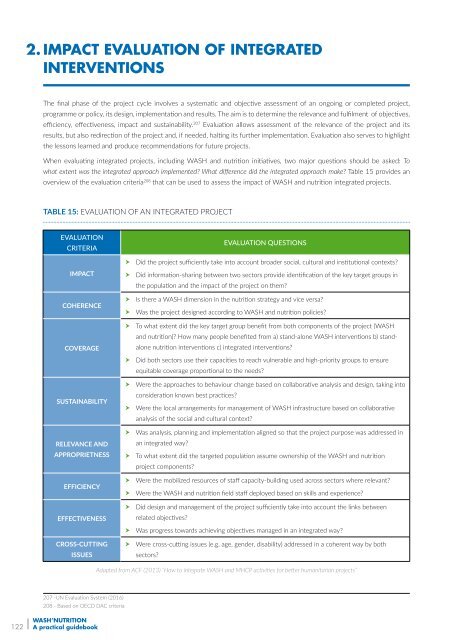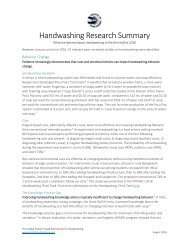WASH’ Nutrition
manuel_wash_nutrition_online
manuel_wash_nutrition_online
You also want an ePaper? Increase the reach of your titles
YUMPU automatically turns print PDFs into web optimized ePapers that Google loves.
2. Impact evaluation of integrated<br />
interventions<br />
The final phase of the project cycle involves a systematic and objective assessment of an ongoing or completed project,<br />
programme or policy, its design, implementation and results. The aim is to determine the relevance and fulfilment of objectives,<br />
efficiency, effectiveness, impact and sustainability. 207 Evaluation allows assessment of the relevance of the project and its<br />
results, but also redirection of the project and, if needed, halting its further implementation. Evaluation also serves to highlight<br />
the lessons learned and produce recommendations for future projects.<br />
When evaluating integrated projects, including WASH and nutrition initiatives, two major questions should be asked: To<br />
what extent was the integrated approach implemented? What difference did the integrated approach make? Table 15 provides an<br />
overview of the evaluation criteria 208 that can be used to assess the impact of WASH and nutrition integrated projects.<br />
Table 15: Evaluation of an integrated project<br />
Evaluation<br />
criteria<br />
Evaluation questions<br />
Did the project sufficiently take into account broader social, cultural and institutional contexts?<br />
IMPACT<br />
COHERENCE<br />
COVERAGE<br />
SUSTAINABILITY<br />
RELEVANCE AND<br />
APPROPRIETNESS<br />
EFFICIENCY<br />
EFFECTIVENESS<br />
CROSS-CUTTING<br />
ISSUES<br />
Did information-sharing between two sectors provide identification of the key target groups in<br />
the population and the impact of the project on them?<br />
Is there a WASH dimension in the nutrition strategy and vice versa?<br />
Was the project designed according to WASH and nutrition policies?<br />
To what extent did the key target group benefit from both components of the project (WASH<br />
and nutrition)? How many people benefited from a) stand-alone WASH interventions b) standalone<br />
nutrition interventions c) integrated interventions?<br />
Did both sectors use their capacities to reach vulnerable and high-priority groups to ensure<br />
equitable coverage proportional to the needs?<br />
Were the approaches to behaviour change based on collaborative analysis and design, taking into<br />
consideration known best practices?<br />
Were the local arrangements for management of WASH infrastructure based on collaborative<br />
analysis of the social and cultural context?<br />
Was analysis, planning and implementation aligned so that the project purpose was addressed in<br />
an integrated way?<br />
To what extent did the targeted population assume ownership of the WASH and nutrition<br />
project components?<br />
Were the mobilized resources of staff capacity-building used across sectors where relevant?<br />
Were the WASH and nutrition field staff deployed based on skills and experience?<br />
Did design and management of the project sufficiently take into account the links between<br />
related objectives?<br />
Was progress towards achieving objectives managed in an integrated way?<br />
Were cross-cutting issues (e.g. age, gender, disability) addressed in a coherent way by both<br />
sectors?<br />
Adapted from ACF (2013) “How to integrate WASH and MHCP activities for better humanitarian projects”<br />
207 -UN Evaluation System (2016)<br />
208 - Based on OECD DAC criteria<br />
122<br />
<strong>WASH’</strong><strong>Nutrition</strong><br />
A practical guidebook



